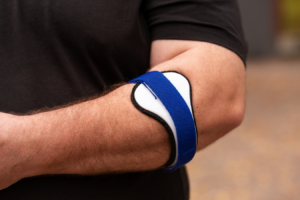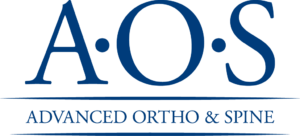You’ve probably heard of the common injuries referred to as “tennis elbow” and “golfer’s elbow”. But what are they? What’s the difference between the two? Read on to learn the answers to these questions and more.
 What is the primary difference between the two injuries?
What is the primary difference between the two injuries?
First, the two have different medical names. “Tennis elbow” is technically known as lateral epicondylitis (LE). However, the technical term for “golfer’s elbow” is medial epicondylitis (ME). Additionally, LE refers to inflammation of tendons that join the forearm muscles on the outside of the elbow. In contrast, ME is inflammation in the tendons that attach the forearm muscles to the inside of the bone at the elbow.
Lateral Epicondylitis (Tennis Elbow)
LE primarily affects the tendons responsible for bending the wrist backwards away from the palm. Naturally, when an athlete swings a tennis racket, their hand bends backwards with the force of the ball giving this condition its name.
Medial Epicondylitis (Golfer’s Elbow)
With ME, the pain comes from the tendons that help bend the hand towards the palm in a downward motion. This condition often presents as inflammation, a possible deformity in the elbow, or a noticeable decrease in range of motion.
 Causes & Symptoms
Causes & Symptoms
Normally, both injuries are caused by repetitive use of the elbow – not solely because of a person’s golf stroke or tennis swing. For example, people who regularly use hand tools like chain shaws, paint brushes, knives, etc. are more susceptible to LE and ME. Additionally, repetitive throwing motions while playing sports can cause either injury. Even those who have weak shoulder or wrist muscles are more likely to experience LE or ME.
What are the symptoms of lateral epicondylitis (tennis elbow)?
Typically, LE starts with mild, bearable pain that comes and goes. But over time the pain usually increases and may cause numbness or weakness down the arm and into the wrist. Most often, tennis elbow occurs in both men and women aged 30 to 50. Common symptoms include:
- Pain, burning, and/or numbness on the outside part of the elbow
- Weak grip strength
What are the symptoms of medial epicondylitis (golfer’s elbow)?
Pain caused by ME may present suddenly or gradually. The pain may get worse with particular movements, such as swinging a golf club. Golfer’s elbow is most often seen in people aged 50 and older. Common symptoms include:
- Pain in the inside of the elbow and possibly down the inner side of the forearm
- Elbow stiffness
- Weakness, including in the hand or wrist
- Numbness or tingling that radiates into one or more fingers – often, the ring and little fingers.
 How are lateral and medial epicondylitis treated?
How are lateral and medial epicondylitis treated?
Thankfully, surgery is very rarely needed to treat tennis or golfer’s elbow. That means these injuries can usually be treated with conservative methods, such as rest, ice, and anti-inflammatory medication. If the pain persists, your doctor may also recommend physical therapy (PT). During PT, the primary focus will be to strengthen the affected muscles, resting if the pain returns. The physical therapist may also use dry needling to help reduce muscle tightness and increase range of motion. Additionally, your doctor may recommend wearing a brace during repetitive activities to limit the stress on the related tendons and muscles. It is also important for patients to know their limits – when to rest so the pain does not affect their everyday life.
When should I talk to a doctor?
As always, if you have any form of undiagnosed chronic and/or severe pain it is important to see an expert ASAP to receive a proper diagnosis and treatment plan. So, if you notice your symptoms are impacting your everyday life, we recommend consulting a physician immediately.
Advanced Ortho and Spine Can Help.
At Advanced Ortho and Spine (AOS), we’ve cared for many patients with tennis and golfer’s elbow. Most are quickly able to get back to living their best lives with conservative treatment. Dr. Erik Maryniw at AOS specializes in treating a variety of orthopaedic conditions, including tennis elbow and golfer’s elbow. Request an appointment online or call us at 615.885.0200 to schedule yours today.
 Dr. Erik Maryniw is a Board-Certified Hand and Upper Extremity Orthopaedic Surgeon at Advanced Ortho and Spine. He provides a full spectrum of orthopaedic care and microvascular surgery from the hand to the shoulder. Contact us today for more information or to request an appointment.
Dr. Erik Maryniw is a Board-Certified Hand and Upper Extremity Orthopaedic Surgeon at Advanced Ortho and Spine. He provides a full spectrum of orthopaedic care and microvascular surgery from the hand to the shoulder. Contact us today for more information or to request an appointment.

With two locations near Nashville in Mt. Juliet and Hermitage, Advanced Ortho and Spine provides patients with high-quality, personalized care while advancing orthopaedic excellence. Contact us today to learn more or to schedule your appointment.
Disclaimer: This blog provides general information and discussions about health and related subjects. The information and other content provided in this blog, or in any linked materials, are not intended and should not be construed as medical advice, nor is the information a substitute for professional medical expertise or treatment.If you or any other person has a medical concern, you should consult with your healthcare provider or seek other professional medical treatment. Never disregard professional medical advice or delay in seeking it because of something read on this blog or in any linked materials. If you think you may have a medical emergency, call your doctor or emergency services immediately.
The opinions and views expressed on this blog and website have no relation to those of any academic, hospital, health practice, or other institution.
